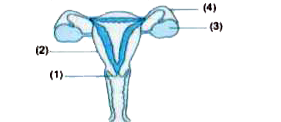Trace a sperm ell from the structure where it is produced to fertilization of the egg
1. Seminiferous tubules
2. Vas deferens
3. Uterus
4. Fallopian tube
5. Vagina
6. Epididymis
7. Urethra
6,1,2,7,5,3,4
1,6,2,7,5,3,4
1,6,2,7,5,4,3
1,2,6,7,5,3,4
The correct Answer is:B
Step by step video, text & image solution for Trace a sperm ell from the structure where it is produced to fertilization of the egg 1. Seminiferous tubules 2. Vas deferens 3. Uterus 4. Fallopian tube 5. Vagina 6. Epididymis 7. Urethra by Biology experts to help you in doubts & scoring excellent marks in Class 12 exams.
Updated on:21/07/2023Topper's Solved these Questions
Similar Questions
Answer question on the basis of your understanding of the following paragraph and the related studied concepts :
(i) When a girl is born, the ovaries already contain thousands of immature eggs
(ii) On reaching puberty, some of these start maturing. One egg is produced every month by one of the ovaries.
(iii) The egg is carried from the ovary to the womb through a thin oviduct or fallopian tube.
(iv) The two oviducts unite into an elastic bag-like structure known as the uterus.
(v) The uterus opens into the vagina through the cervix.

How many eggs are produced each month and why ?
View SolutionAnswer question on the basis of your understanding of the following paragraph and the related studied concepts :
(i) When a girl is born, the ovaries already contain thousands of immature eggs
(ii) On reaching puberty, some of these start maturing. One egg is produced every month by one of the ovaries.
(iii) The egg is carried from the ovary to the womb through a thin oviduct or fallopian tube.
(iv) The two oviducts unite into an elastic bag-like structure known as the uterus.
(v) The uterus opens into the vagina through the cervix.

What is the site of fertilisation ?
View Solution
Knowledge Check
Given below is a statement with some blanks. Fill up the blanks correctly -
The male reproductive system consists of two testes. Each testis contains thin folded tubes called the --A-- which meiosis takes place to produce the male gametes, the sperms. These sperms move tothe --B-- (a highly coiled tube formed from the merging of the seminiferous tubules), and then tothe --C-- or sperm duct. The two vasa deferentia merge to form the urethra, which travels to the outside of the body through the penis The cells located between the seminiferous tubules are called --D-- cells and they are responsible for the formation of the male hormone, --E--AA - Seminiferous tubules, B - epididymis, C - vas deferens, D - interstitial cellsBA - Seminiferous tubules, B - epididymis, C - ejaculatory duct, D - interstitial cellsCA - Seminiferous tubules, B - epididymis, C - vas deferens, D - interstitial cellsDA - Uriniferous tubules, B - epididymis, C - vas deferens, D - interstitial cellsWhile moving through the male reproductive system sperm passes through following structures
a. Seminiferous tubule
b. Epididymis
c. Urethra
d. Rete testis
e. Vasa efferentia
f. Ejaculatory duct
g. Vas deferensAa → d → e → b → g → f → cBa → e → d → b → f → g → cCa → b → d → g → f → e → cDa → e → b → d → g → c → fHow many is / are an incorrect matches in the following ?
(1) Menopause : Cessation of menstruation in primate females.
(2). Cleavage : Rapid meiotic cell division occurs inside the fallopian tube .
(3). Spermiation : Release of sperms from the epididymis to penile urethra.
(4) Implantation : The embedding of blastocyst to the myometrium of the uterus which leads to pregnancy.AThreeBOneCFourDTwo
Answer question on the basis of your understanding of the following paragraph and the related studied concepts :
(i) When a girl is born, the ovaries already contain thousands of immature eggs
(ii) On reaching puberty, some of these start maturing. One egg is produced every month by one of the ovaries.
(iii) The egg is carried from the ovary to the womb through a thin oviduct or fallopian tube.
(iv) The two oviducts unite into an elastic bag-like structure known as the uterus.
(v) The uterus opens into the vagina through the cervix.

Based on the diagram (1 - 4) and statements [(in) - (v)] given above match the information.
View SolutionAnswer question on the basis of your understanding of the following paragraph and the related studied concepts :
(i) When a girl is born, the ovaries already contain thousands of immature eggs
(ii) On reaching puberty, some of these start maturing. One egg is produced every month by one of the ovaries.
(iii) The egg is carried from the ovary to the womb through a thin oviduct or fallopian tube.
(iv) The two oviducts unite into an elastic bag-like structure known as the uterus.
(v) The uterus opens into the vagina through the cervix.

Give suitable terms for starting and ending of reproductive phase in human females.
View SolutionFind the correct match.
1-Prostate , 2-Bulbourethral, 3-Ejaculatory duct , 4-seminal vesicle, 5-vas deferens.

View Solution(a) Some men have abnormally low sperm count in seminal fluid. Also. Some women cannot normally conceive because of any of the following reasons: (i) They cannot produce ova, (ii) They have blocked oviducts, or (iii) They have spermicidal secretions in the vagina.
In such couples, one technique is commonly used. Name that Assisted Reproduction Technique.
(b) At what stage, fertilized egg is transferred into the fallopian tube or uterus of the mother in this technique ?
View SolutionPick the odd one out from each series given below and select the correct option.
(i) Scrotum, rate testis, Fallopian tube, vas deferens
(ii) Ovary, uterus, vagina, ejaculatory duct
(iii) Acrosome, Graafian follicle, corpuse luterum, cervix
(iv) Prostate, tesite seminal vesicles, Cowper's gland
View Solution
